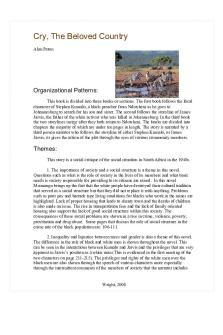The Country Wife - 1111 PDF

| Title | The Country Wife - 1111 |
|---|---|
| Course | Introducción a los estudios literarios en lengua inglesa |
| Institution | Universidad de Oviedo |
| Pages | 1 |
| File Size | 38.9 KB |
| File Type | |
| Total Downloads | 46 |
| Total Views | 148 |
Summary
1111...
Description
The Country Wife The playwright is William Wycherley, this play was published in 1675 and it belongs to the restoration drama, more specifically the comic satire or “comedy of manners”. In Act 4, scene 1 there is a couple, Mr and Mrs. Pinchwife who argue over the wife’s infidelity, the husband makes her write a letter to her secret lover, Mr. Horner. In this scene there are only two characters, Mr and Mrs Pin but they mention Mr. Horner, however he does not appear. The stage directions are conjunctive and explicit, they go along the actor’s lines and are wirtten in between the dialogues, An example of an explicit stage direction would be “Takes the paper and reads. There are implicit ones as well, for instance: “I will write Whore with this Penknife in your Face” there is not any stage direction that implies that Mr. Pin is holding a penkinfe, but it is necessary for him to do so because otherwise it would not make sense. Mr. Pin has a lot of “asides”, he talks to the audience and Mrs. Pin who is also on stage has to pretend she does not hear him, for instance: “Yes you may when your Husband bids you write Letters to people that are in Town” Towards the end of the play Mrs. Pin does a monologue, she is torn between sending the awful letter her husband made her write with very unpleasant comments about Mr. Horner or the one she wrote after her husband left the room. She puts the blame of her infidelity on her husband saying that he taught her how to write so now she can send long letters to Mr. Horner. The characters self-characterize throught their own actions, they are flat and stereotypes: a jealous husband, a cuckold...The themes here are “love” and the unhappy marriage: Mrs. Pin is constantly insulted and understimated by her husband. This play shows life at the time, it is characterised by bawdiness, excess and the liberty after the Interrregnum....
Similar Free PDFs

The Country Wife - 1111
- 1 Pages

The Country Wife Summary
- 8 Pages

The River Merchant\'s Wife
- 1 Pages

THE WIFE OF BATH
- 2 Pages

The wife of bath riassunto
- 12 Pages

The wife´s lament analysis
- 4 Pages

Bharat the wife of bath seminar
- 6 Pages

Cry, the Beloved Country Essay
- 3 Pages

Cry, the Beloved Country - Diary
- 7 Pages

Accounting elemets reviewer 1111
- 3 Pages

1111 - articulo e informático
- 4 Pages

My Economics Notes 1111
- 62 Pages

41 - 1111
- 4 Pages

RANDOM ACTIVITY 1111
- 9 Pages

Ensayo Resolucion 1111
- 3 Pages
Popular Institutions
- Tinajero National High School - Annex
- Politeknik Caltex Riau
- Yokohama City University
- SGT University
- University of Al-Qadisiyah
- Divine Word College of Vigan
- Techniek College Rotterdam
- Universidade de Santiago
- Universiti Teknologi MARA Cawangan Johor Kampus Pasir Gudang
- Poltekkes Kemenkes Yogyakarta
- Baguio City National High School
- Colegio san marcos
- preparatoria uno
- Centro de Bachillerato Tecnológico Industrial y de Servicios No. 107
- Dalian Maritime University
- Quang Trung Secondary School
- Colegio Tecnológico en Informática
- Corporación Regional de Educación Superior
- Grupo CEDVA
- Dar Al Uloom University
- Centro de Estudios Preuniversitarios de la Universidad Nacional de Ingeniería
- 上智大学
- Aakash International School, Nuna Majara
- San Felipe Neri Catholic School
- Kang Chiao International School - New Taipei City
- Misamis Occidental National High School
- Institución Educativa Escuela Normal Juan Ladrilleros
- Kolehiyo ng Pantukan
- Batanes State College
- Instituto Continental
- Sekolah Menengah Kejuruan Kesehatan Kaltara (Tarakan)
- Colegio de La Inmaculada Concepcion - Cebu
